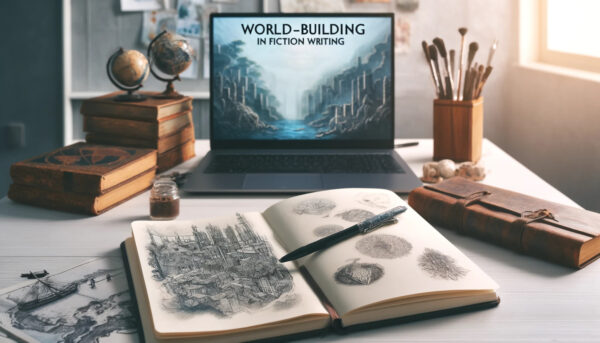World-building serves as the cornerstone of compelling and immersive fiction, providing the rich tapestry against which stories unfurl and characters thrive. This meticulous process involves crafting the very essence of a story’s backdrop—the environments, social structures, economies, and histories that breathe life into the narrative. It’s what elevates a simple plot into a vibrant world that readers can explore and inhabit. The significance of world-building lies in its transformative power, transporting readers to realms beyond their imagination and rendering fantastical narratives both believable and relatable.
In this article, we delve into the art and importance of world-building in fiction writing. Beyond merely showcasing iconic examples like Middle Earth, Hogwarts, and the “Star Wars” universe, we aim to explore the fundamental principles and strategies that underpin effective world-building. Through careful examination and analysis, we seek to provide fantasy writers with practical insights and techniques to craft immersive worlds that captivate readers and enrich their storytelling.
From the basics of geography and culture to the complexities of magic systems and societal structures, our goal is to empower writers to embark on their world-building journeys with confidence and creativity. Whether you’re a seasoned fantasy author or a newcomer to the craft, we invite you to join us on this exploration of world-building and unlock the limitless possibilities it offers for storytelling.
The Essence of World Building in Fiction Writing
World-building in fiction writing is the art and craft of constructing an imaginary universe with coherent qualities such as history, geography, ecology, and culture. It is an essential component of storytelling that provides a setting for the narrative and characters to develop, offering depth and realism to the fictional world, regardless of its fantastical elements. The essence of world-building lies not only in the creation of a backdrop but also in imbuing the narrative with a sense of place and time that is both compelling and convincing. This meticulous construction of a fictional universe enables writers to establish a framework within which the story can unfold consistently and believably.
The significance of world-building cannot be overstated, as it directly influences the reader’s ability to suspend disbelief and fully engage with the story. A well-constructed world serves as a canvas upon which the narrative paints its tales, allowing readers to immerse themselves in a reality that, while fictional, feels tangible and plausible. This immersion is achieved through the careful integration of details that breathe life into the world, from the sprawling landscapes and bustling cities to the social norms and cultural practices of its inhabitants. When readers can visualize the setting in vivid detail and understand the underlying rules that govern it, they are more likely to form emotional connections with the characters and their journeys.
Start Your Publishing Journey FOR FREEIn the realms of both science fiction and fantasy, world-building takes on a pivotal role due to the genres’ inherent departure from the familiar constraints of the real world. Science fiction worlds often explore futuristic technologies, space exploration, and alternative societies, requiring a careful balance between scientific plausibility and imaginative innovation. Fantasy worlds, on the other hand, delve into the realms of magic and myth, creating settings where the impossible becomes possible. However, even in these fantastical environments, internal consistency is key; the world’s magic systems, creatures, and cultures need to adhere to their own set of rules to maintain believability.
The role of world-building in these genres extends beyond mere backdrop creation; it shapes the narrative’s possibilities and constraints, influencing character development and plot progression. For instance, the political structure of a fantasy kingdom or the technological advancements of a sci-fi civilization can drive the story’s conflict and resolution. By establishing a rich and detailed world, writers not only captivate their audience’s imagination but also set the stage for storytelling that resonates with depth, complexity, and authenticity.
Crafting a Fictional World: Where to Begin?
Crafting a fictional world is akin to weaving a tapestry, where each thread represents a different aspect of the world’s fabric. This intricate process begins with the fundamentals, gradually building complexity and depth. Here’s how to start:
Starting with the Basics
The journey into world-building starts with the establishment of geography, climate, and the natural environment, which form the physical canvas of your world. These elements influence everything from the layout of cities to the lifestyle of their inhabitants.
Geography: Mountains, rivers, forests, and deserts shape the physical journey of characters and influence the social development of societies.
Climate: Impacts agricultural practices, economic activities, attire, and architecture of different regions.
Natural Environment: The flora, fauna, and natural resources available, shape economic and social structures.
Establishing the Social Structure
With the stage set by geography and climate, the next step is to construct the social structure of the world, including class systems, governance, and political structures.
Class Systems: Consider whether your world has social hierarchies based on birthright, wealth, or merit, and how these influence daily life and conflicts.
Governance and Political Structure: Define the form of government and how power is distributed among kingdoms, republics, empires, or tribal communities.
Delving into Cultural Aspects
Cultural aspects are the soul of your fictional world, encompassing religions, festivals, traditions, and norms that define the identity of its inhabitants.
Religions: Shape the moral and ethical framework of your world, influencing laws, customs, and conflicts.
Festivals and Traditions: Offer a glimpse into the heritage of your fictional societies, enriching the narrative with color and vibrancy.
Integrating Technological and Magical Elements
No fictional world is complete without its unique technological or magical elements. These must be consistent and integral to the world’s functioning.
Technology: In science fiction, technology reflects the advancement and innovation of societies, shaping their capabilities and worldviews.
Magic Systems: In fantasy fiction, magic offers a realm of possibilities, with clear rules and limitations to prevent them from becoming deus ex machina solutions.
Crafting a fictional world is a complex but rewarding endeavor that sets the foundation for a compelling narrative. By meticulously developing the geography, social structure, cultural aspects, and technological or magical elements of your imaginary world, you create a rich, immersive environment where stories can flourish and characters can embark on unforgettable journeys.
Building on the Real and the Imaginary
In the intricate process of world-building, the line between the real and the imaginary is often a source of boundless creativity. Writers weave together elements from history, culture, mythology, and their imagination to create worlds that resonate with authenticity and wonder. This section explores how to draw inspiration from various sources and balance them to craft a compelling fictional universe.
Drawing Inspiration from Real-World History and Cultures
The tapestry of real-world history and diverse cultures provides a rich repository of material for world-building. Historical events, societal structures, technological advancements, and cultural practices offer a wealth of ideas that can be adapted and reimagined for fictional worlds. For instance, the intricate political machinations of medieval Europe can inspire the governance systems of a fantasy kingdom, while the technological innovations of the Industrial Revolution might inform the development of a steampunk universe. Delving into different cultures can also enrich a world with unique social norms, artistic expressions, and philosophical beliefs, providing depth and color to the narrative.
Start Your Publishing Journey FOR FREEIncorporating Elements from Existing Myths, Legends, and Speculative Fiction
Myths and legends are the original world-building endeavors, filled with gods, monsters, heroes, and magical realms. These stories, steeped in the collective consciousness of cultures around the world, offer a treasure trove of themes, motifs, and archetypes to draw from. Similarly, the realms of speculative fiction—encompassing science fiction, fantasy, and beyond—present a panorama of imaginative worlds that can spark new ideas. Incorporating such elements into your world-building not only pays homage to the tradition of storytelling but also connects your narrative to the timeless human penchant for myth-making.
Balance between Borrowing from the Real World and Inventing New Aspects
While drawing from real-world history, cultures, myths, and existing fiction can provide a solid foundation for your world, the magic of world-building lies in how you transform these elements into something uniquely your own. The challenge and artistry come from striking a balance between borrowing from reality and inventing new, imaginative aspects. This balance ensures that your world feels both familiar enough to be relatable and strange enough to be captivating.
To achieve this equilibrium, consider how you can twist and meld your inspirations to serve your narrative’s needs. Perhaps your world’s magic system is influenced by real scientific principles, or its mythology intertwines with historical events from our world, reinterpreted in a fantastical context. The key is to use the real as a springboard for the imagination, allowing your world’s history to resonate with authenticity while soaring into the realms of the extraordinary.
In summary, the process of inspiration and research in world-building is a dynamic interplay between the real and the imagined. By skillfully blending these elements, a writer crafts a rich world, that is not only a backdrop for the story but a living, breathing character in its own right, inviting readers to step into a space where the familiar dances with the fantastical.
The Pillars of a Fictional Universe
Creating a fictional universe that captivates and immerses readers requires meticulous attention to its foundational pillars. These pillars—history and lore, magic or technological systems, and societal constructs—form the backbone of any well-developed world, providing depth, context, and realism. Let’s delve into each of these critical aspects:
Crafting a Rich History and Lore
The history and lore of a fictional universe serve as the tapestry upon which current events and future possibilities are painted. This historical backdrop includes creation myths, significant wars, pivotal discoveries, and cultural shifts that have shaped the world and its inhabitants. A richly detailed past lends a sense of permanence and reality to the fictional setting, allowing readers to feel as though they are glimpsing a living world with its very own history, memories, and scars.
To create this depth, consider the following:
Chronology: Develop a timeline that outlines key historical events, from the genesis of your world to the present moment in your narrative.
Mythology and Legends: Craft myths and legends that characters in your world might believe in or tell as stories, which can add layers of cultural depth and inform societal values.
Historical Conflicts: Detail past conflicts that have shaped political borders, societal fears, and alliances, as these tensions often drive current and future narratives.
Developing a Unique and Consistent Magic System or Technological Framework
Whether your world is steeped in magic or advanced technology, the systems governing these elements must be unique, consistent, and integral to the world’s functioning. A well-thought-out magic system or technological framework not only enriches the world but also sets the stage for plot development and character growth.
Consider these elements:
Rules and Limitations: Establish clear rules and limitations for your magic or technology to ensure it doesn’t become a catch-all solution to problems, maintaining narrative tension.
Cultural Impact: Explore how magic or technology affects everyday life, social hierarchy, and cultural practices, reinforcing its integration into the world.
Innovation and Conflict: Use the development of magic or technology as a driver for innovation, conflict, and plot progression, reflecting its importance in the world.
Constructing Societies and Their Interactions
The societal constructs of your fictional universe—including class systems, economies, and international relations—form the social fabric in which characters operate. These elements dictate interactions, conflicts, and the overall dynamics of the narrative.
Key considerations include:
Social Hierarchy: Define the class or caste system, exploring the divisions and privileges that characterize different societal segments.
Economic Systems: Detail the economy, trade relations, and resources that drive conflict and cooperation between different regions or groups.
Political Alliances and Tensions: Map out the political landscape, including alliances, rivalries, and treaties that govern international relations, providing a realistic backdrop for the narrative.
By thoroughly developing these pillars, a writer constructs a fictional universe that feels tangible and immersive. A world with a rich history and lore gives characters and stories a meaningful context; a unique and consistent magic or technological system adds wonder and challenges; and complex societal constructs mirror the intricate dynamics of real-world interactions. Together, these elements form the bedrock of a captivating fictional universe, inviting readers to explore and engage with a world beyond their own.
The Role of Characters in World-Building
In the intricate tapestry of world-building, characters serve as the threads that bring the fictional universe to life. They not only inhabit the world but also embody its values, challenges, and complexities, acting as conduits through which readers explore the intricacies of the setting. This section examines the pivotal role of characters in world-building and how they interact with their environment and society to drive plot and development.
Start Your Publishing Journey FOR FREECharacters as Embodiments of the World
Characters are more than just individuals; they are products of their environment, shaped by the world they inhabit. From their beliefs and motivations to their mannerisms and language, characters reflect the cultural, social, and historical context of the world around them. Whether they are heroes, villains, or ordinary citizens, characters offer insights into the nuances of the world, revealing its diversity, contradictions, and aspirations.
Cultural Identity: Characters embody the cultural norms, traditions, and values of their society, providing readers with a window into its customs and beliefs.
Social Status: Characters’ social standing and interactions highlight the inequalities, hierarchies, and power dynamics present in the world, offering commentary on its societal structures.
Historical Context: Characters may carry personal histories or legacies that connect them to significant events or conflicts in the world’s past, enriching the narrative with depth and continuity.
The Impact of Environment and Society on Character Development
The world’s environment and society play a profound role in shaping characters’ development, motivations, and relationships. From the landscapes they traverse to the communities they belong to, characters navigate a web of influences that mold their identities and trajectories. These interactions not only drive character arcs but also propel the plot forward, creating a dynamic interplay between individual agency and broader societal forces.
Environmental Challenges: Characters confront the physical obstacles and dangers present in the world’s landscapes, forcing them to adapt, innovate, or persevere in the face of adversity.
Social Dynamics: Characters navigate the complexities of interpersonal relationships, societal expectations, and cultural norms, which shape their decisions and behaviors.
Conflict and Resolution: Characters’ struggles against external threats or internal conflicts reflect the tensions and dilemmas inherent in the world, driving the narrative towards resolution or transformation.
In essence, characters are the heart and soul of world-building, breathing life into the fictional universe and guiding readers through its wonders and challenges. By embodying the world they inhabit and navigating its complexities, characters illuminate the nuances of the setting, deepen reader engagement, and ultimately, make the world feel vivid, vibrant, and real.
Challenges and Solutions in World-Building
World-building is a complex and rewarding endeavor, but it comes with its own set of challenges. From the temptation to overcomplicate to the struggle to maintain consistency, writers must navigate various pitfalls to create a coherent and immersive fictional world. This section explores some common challenges in world-building and offers strategies to overcome them.
Common Pitfalls in World-Building
Overcomplication: One of the most common pitfalls in world-building is the temptation to include every detail, leading to overwhelming complexity that can bog down the narrative.
Inconsistency: Inconsistencies in the world’s rules, geography, or history can disrupt reader immersion and undermine the credibility of the fictional universe.
Info-dumping: Another challenge is presenting world-building information in a way that feels natural and integrated into the narrative, rather than overwhelming readers with lengthy exposition.
Strategies for Maintaining Coherence and Depth
Start Small: Begin with the essentials of world-building—geography, society, and culture—and gradually expand as the story unfolds, adding depth and detail organically.
Create a Bible: Develop a world-building “bible” or reference document that outlines key world-building elements such as maps, timelines, and cultural norms to ensure consistency throughout the writing process.
Show, Don’t Tell: Rather than relying on exposition to convey world-building details, incorporate them into character interactions, dialogue, and action to immerse readers in the world.
Seek Feedback: Share your world-building with beta readers or critique partners to identify inconsistencies or areas that need further development, gaining valuable perspectives to refine your fictional universe.
By recognizing common challenges and employing strategic solutions, writers can navigate the complexities of world-building with confidence, creating cohesive and immersive fictional worlds that captivate readers and stand the test of time.
World-Building in Action: Case Studies
Focusing on two particular books provides a deeper analysis of their world-building intricacies and their impact on their narratives.
“The Hunger Games” by Suzanne Collins
Suzanne Collins’ “The Hunger Games” presents a dystopian world of Panem, divided into twelve districts and the Capitol, each with distinct cultures, economies, and challenges. The stark divide between the opulent Capitol and the impoverished districts reflects themes of inequality and oppression, resonating with real-world social issues. Collins intricately crafts the brutal arena of the Hunger Games, where tributes battle to the death, immersing readers in a visceral and harrowing experience that underscores the stakes of survival. Through vivid descriptions and compelling character perspectives, Collins creates a world that feels both chillingly familiar and unsettlingly plausible, driving home the novel’s themes of power, sacrifice, and resilience.
“His Dark Materials” Trilogy by Philip Pullman
Philip Pullman’s “His Dark Materials” trilogy transports readers to a multiverse rich with mythology, philosophy, and wonder. Pullman intricately weaves together elements of science, religion, and fantasy to create a magical world, where humans are accompanied by daemons, sentient manifestations of their souls. From the bustling streets of Oxford to the ethereal landscapes of parallel universes, Pullman’s world-building is expansive and immersive, inviting readers on a journey of discovery and introspection. Through intricate world-building and nuanced character development, Pullman explores complex themes of free will, authority, and the nature of existence, crafting a narrative that resonates with depth and relevance.
These case studies exemplify how effective world-building can elevate storytelling, creating immersive environments that resonate with readers long after the final page is turned. Through meticulous attention to detail and thematic coherence, Collins and Pullman have crafted fictional worlds that captivate the imagination and provoke thought, showcasing the transformative power of immersive world-building in fiction.
Publishing With Spines
When it comes to publishing your book, platforms like Spines offer a streamlined and efficient solution. Spines is an AI-powered publishing platform that provides authors with a user-friendly publishing platform that empowers them to bring their work to readers worldwide. With BooxAI, authors can easily upload and format their manuscripts, customize their book covers, and set pricing and distribution preferences.
Spines also offers marketing tools and analytics to help authors reach their target audience and track their book’s performance. Additionally, Spines provides authors with access to a global network of retailers and libraries, maximizing exposure and potential sales. Overall, Spines offers authors a convenient and cost-effective way to publish and distribute their books, helping them achieve their publishing goals with ease. Sign up for free to publish your book!
Start Your Publishing Journey FOR FREEIn conclusion, successful world-building in fiction hinges on key components such as rich history, consistent rules, and believable characters. Writers should embrace the complexity and creativity involved in crafting immersive environments, recognizing that world-building is as much an art as it is a craft. By meticulously developing their worlds and characters, authors can create narratives that resonate with depth, authenticity, and emotional resonance. So, let your imagination soar, and embark on the journey of crafting your own immersive worlds—one detail at a time.
Frequently Asked Questions
1. What is world-building in fiction writing?
World-building is the process of creating a fictional universe, complete with its own geography, history, cultures, societies, and rules, to serve as the backdrop for a story.
2. Why is world-building important in fiction writing?
World-building enhances the reader’s experience by creating immersive environments that feel believable and engaging. It adds depth to the narrative, fosters reader immersion, and allows for the exploration of themes and conflicts unique to the fictional world.
3. How do I start world-building for my fiction writing?
Begin by establishing the basics, such as geography, climate, and societal structure. Then delve into cultural aspects, technological or magical systems, and the history of your world. Start with broad strokes and gradually add detail as needed.
4. What are some common pitfalls to avoid in world-building?
Common pitfalls include overcomplication, inconsistency, and excessive exposition. Strive for coherence, consistency, and balance in your world-building, ensuring that every element serves the story without overwhelming the reader.
5. How do I ensure that my world-building remains consistent throughout my narrative?
Keep a world-building bible or reference document to track important details, such as maps, timelines, and cultural norms. Continuously refer back to this document to maintain coherence and avoid contradictions.









